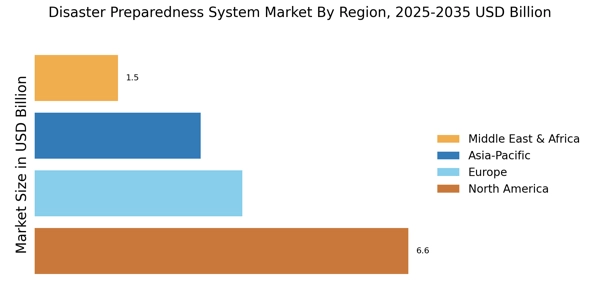The Disaster Preparedness System Market is characterized by a dynamic competitive landscape, driven by increasing global awareness of disaster risks and the necessity for robust preparedness strategies. Key players such as Honeywell (US), Siemens (DE), and IBM (US) are at the forefront, each adopting distinct strategies to enhance their market positioning. Honeywell (US) focuses on innovation in smart building technologies, integrating IoT solutions to improve emergency response capabilities. Siemens (DE) emphasizes regional expansion, particularly in Asia-Pacific, where urbanization necessitates advanced disaster management systems. Meanwhile, IBM (US) is leveraging its expertise in artificial intelligence to develop predictive analytics tools that enhance decision-making during crises. Collectively, these strategies not only bolster individual company profiles but also intensify competition within the market, as firms strive to differentiate themselves through technological advancements and tailored solutions.
In terms of business tactics, companies are increasingly localizing manufacturing to reduce lead times and enhance supply chain resilience. This approach is particularly relevant in the context of the Disaster Preparedness System Market, where timely response is critical. The market structure appears moderately fragmented, with several key players holding substantial market shares while numerous smaller firms contribute to niche segments. The collective influence of these major players shapes the competitive dynamics, as they engage in strategic partnerships and collaborations to enhance their service offerings and market reach.
In August 2025, Honeywell (US) announced a partnership with a leading telecommunications provider to develop a next-generation emergency communication system. This collaboration aims to integrate advanced communication technologies into disaster response frameworks, thereby enhancing real-time information dissemination during emergencies. The strategic importance of this move lies in its potential to significantly improve coordination among first responders and local authorities, ultimately leading to more effective disaster management.
In September 2025, Siemens (DE) launched a new suite of disaster management software tailored for urban environments, focusing on predictive modeling and resource allocation. This initiative reflects Siemens' commitment to addressing the unique challenges posed by densely populated areas, where traditional disaster response methods may fall short. The introduction of this software is likely to position Siemens as a leader in urban disaster preparedness, catering to municipalities seeking to enhance their resilience against natural disasters.
In July 2025, IBM (US) unveiled an AI-driven platform designed to assist organizations in developing comprehensive disaster recovery plans. This platform utilizes machine learning algorithms to analyze historical data and simulate various disaster scenarios, enabling organizations to prepare more effectively. The strategic significance of this development is profound, as it not only showcases IBM's technological prowess but also addresses a critical need for organizations to adopt data-driven approaches in their disaster preparedness efforts.
As of October 2025, the competitive trends within the Disaster Preparedness System Market are increasingly defined by digitalization, sustainability, and the integration of artificial intelligence. Strategic alliances are becoming more prevalent, as companies recognize the value of collaborative efforts in enhancing their service offerings. Looking ahead, it is anticipated that competitive differentiation will evolve, shifting from traditional price-based competition to a focus on innovation, technological advancements, and the reliability of supply chains. This transition underscores the necessity for companies to invest in cutting-edge solutions that not only meet current demands but also anticipate future challenges in disaster preparedness.


















Leave a Comment